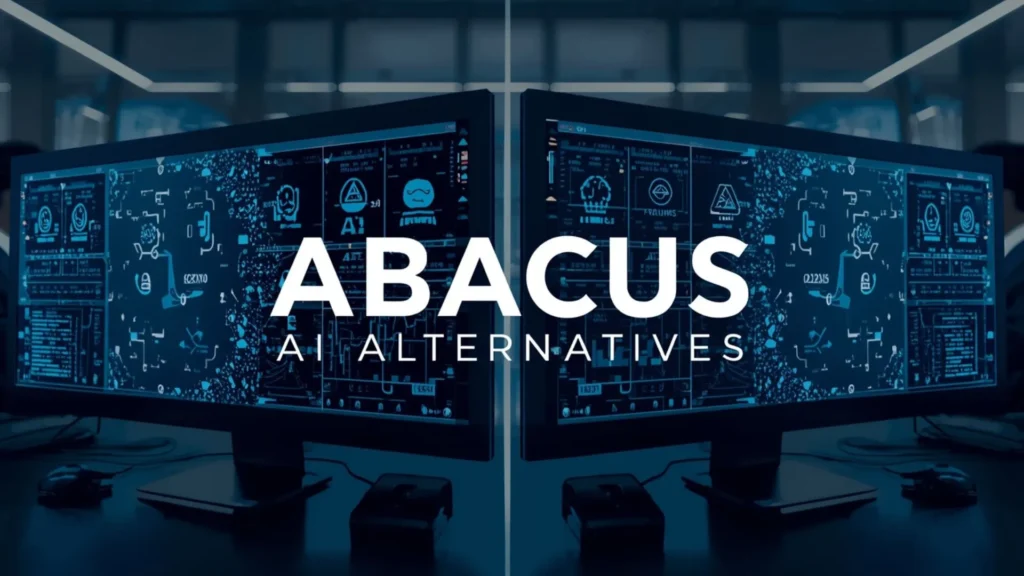Think about having a large box of LEGOs. You can create whatever you wish, a car, a house or a spaceship. Artificial Intelligence (AI) platforms are the LEGO boxes in the computer world. They provide you with the means and bricks to create intelligent programs which are able to learn, predict, and make decisions.
There is one extremely popular set of AI LEGOs known as Abacus AI. It is an excellent platform that assists individuals in creating any type of amazing AI projects. However, there are occasions when you require another type of LEGO box. Perhaps you require one that is easier to use, a special one that is needed in a special project, or is more affordable.
This is what this article is all about. We are going to consider the world of AI platforms outside of Abacus AI. We are going to discuss ten other great Abacus Ai alternatives toolkits with which you can make your AI ideas come to existence. You are either constructing something that is part of a school project or a large enterprise, and there is an ideal AI platform you can find.
What is Abacus AI?
Imagine that Abacus AI is a very intelligent assistant that creates other intelligent objects. It is a one-stop platform in which you can create, utilize, and operate your own AI systems. The most interesting thing is that it attempts to make everything as simple as possible. It does not require being a high-level computer scientist to use it. It assists you in all the steps.
To illustrate, we will assume that a company would like to make a guess on what customers would cease purchasing. They are able to enter all their customer details into the Abacus AI. The platform purifies the data, discovers the most suitable means of learning out of it, and constructs a special AI model. That model can then consider a new customer and make a good estimation of whether they will leave. Abacus AI simplifies this entire process and leaves it quick.
Important characteristics and functions:
- End-to-End Platform: It is the entirety of start to finish. It assists you in cleaning your data, developing the AI and launching it.
- AutoML: It automatically identifies the most suitable AI model to use with your data, and thus you do not need to experiment with a large number of models.
- Various Applications: You can forecast sales, evaluate customer responses, or find unusual trends in your data.
- User-friendly: It is user-friendly with a simple interface that allows you to click and drag rather than write complex code.
Why Do People Want Abacus AI Alternatives?
Abacus AI Alternatives is not a bad tool, although not all people can use it. Individuals and companies need different tools and in some cases another tool could suit them better.
The following are some of the typical causes of someone seeking an alternative.
- Cost: There are expensive AI platforms. An amateur or a small team may wish to start with a cheaper or a free choice.
- Special Requirements: Certain projects require a specialist platform, such as Databricks in the case of very large data.
- Desiring Greater Control: other professionals would like to use a platform that allows them to write their own code and create everything on their own.
- Compatibility with Other Tools: When a company already uses tools in Google, Amazon, or Microsoft, it will be easier to integrate an AI platform in the same company.
- Trying Something New: AI is a rapidly expanding field, and new tools continue to emerge. Discovering an alternative can allow one to discover a new favorite tool.
Top 10 Abacus AI Alternatives
At this point, we will explore each of these fantastic Abacus AI Alternatives platforms in greater detail. We will discuss the uniqueness of each of them.
1. DataRobot
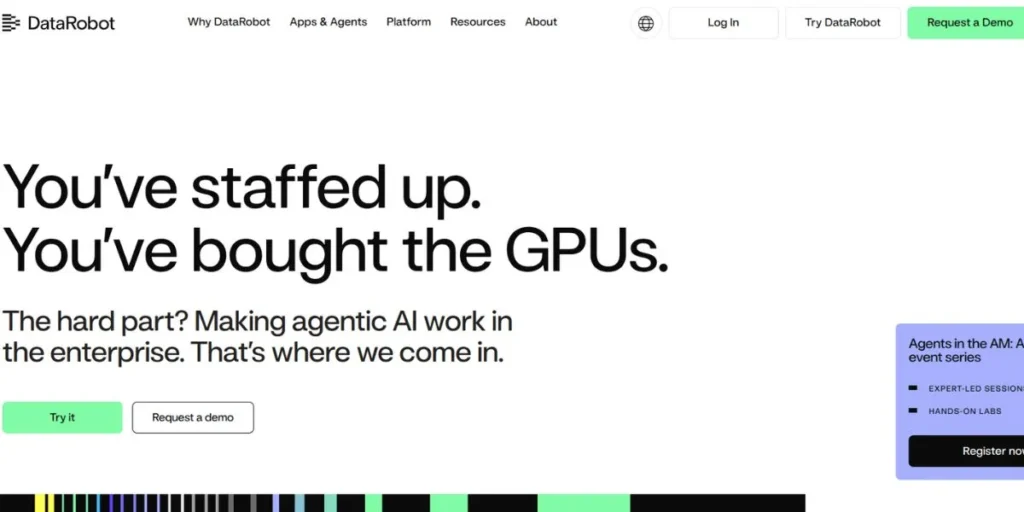
DataRobot is the equivalent of a team of robot data scientists and best Abacus AI Alternatives. Its primary objective is to simplify AI to businesses. It automatically does almost everything. You feed it your data, inform it of what you wish to predict and DataRobot works. It searches hundreds of various AI models in the background and displays the most effective to you. It reasons why it selected a given model, hence you can have confidence in the findings.
It is an ideal platform that companies may opt to use this Abacus AI Alternatives to address real issues immediately without having to pay a large number of professionals. It is useful to take you through a basic idea into a full-fledged AI solution in a very short time. It handles the complex aspects so you can concentrate on what the results are to your business.
Key Features:
- Automated Machine Learning (AutoML): It uses a large number of models, which are automatically constructed and tested to identify the best one.
- Time Series Modeling: It is used to predict things that occur with time, such as the sales next month.
- MLOps: This will assist you in managing and monitoring your AI models once you begin using them, as a way of ensuring that they continue to remain healthy.
- Explainable AI: It gives you the way its AI models make their choices, such that the output is not a black box.
Pros:
- Extremely rapid in constructing high quality models.
- User-friendly, even to individuals not an expert in AI.
- high emphasis on business performance.
- Excellent capabilities to handle the entire AI lifecycle.
Cons:
- It is potentially quite costly, particularly when it comes to large businesses.
- It may be excessively automated to allow professionals to manipulate it.
Pricing:
DataRobot is privately listed. You should call their sales people and request a tailor-made quote. They have a free trial in case you want to test it.
Website:
https://www.datarobot.com
2. H2O.ai

H2O.ai is a great Abacus AI Alternatives. It is a well-known brand in the AI industry, particularly on the side of developers and data scientists. Consider it to be a strong engine, which you may apply to create your own custom AI solutions. It provides a well-known open-source platform, which implies that anyone can free download and use it. This renders it an excellent option among students, researchers and people who enjoy experimenting.
H2O.ai is highly rapid and is able to process extensive data. The company has a paid version called H2O AI Cloud that provides businesses with additional functionality and service. There are additional tools of automation (such as DataRobot), such as Driverless AI, in this version.
Key Features:
- OpenSource Core: A free and powerful platform with a huge community.
- H2O AI Cloud: A complete platform for large enterprises that features AutoML and MLOps software.
- High Performance: It is designed to be highly fast and is capable of running over other popular data systems.
- Language Friendly It is compatible with common coding languages, such as Python and R.
Pros:
- The free version is the open-source one and is highly powerful.
- Many data scientists all over the world trust it and use it.
- It provides much control to professionals.
- The company continues to develop novel and advanced AI tools.
Cons:
- Other platforms might require a less technical aptitude than the open-source tool does.
- The Enterprise version is complicated to install.
Pricing:
The basic H2O 3 platform is open-source. The H2O AI Cloud is also priced on request.
Website:
https://h2o.ai
3. Google Cloud AI (Vertex AI)
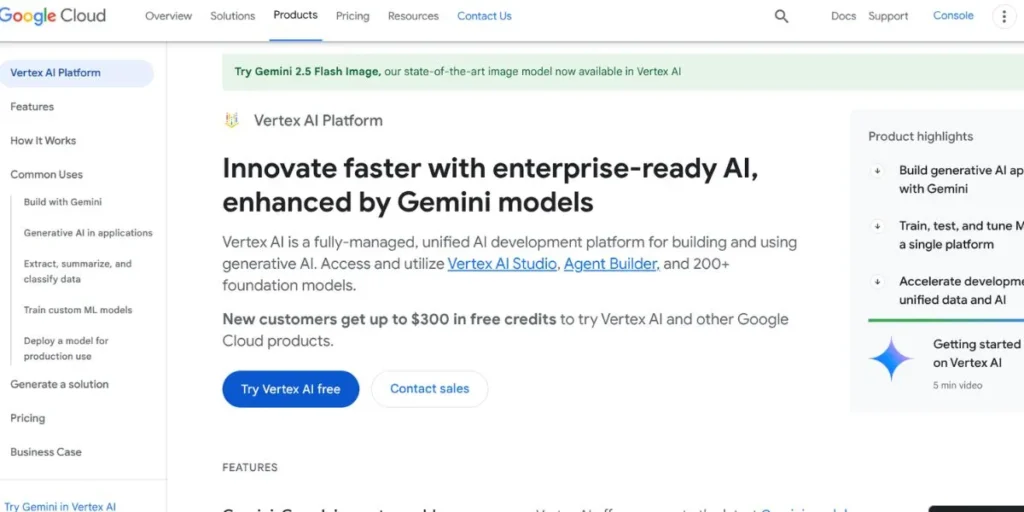
Google is a technology giant, and it is not surprising that they have one of the best Abacus AI Alternatives platforms. Vertex AI is a single platform of Google machine learning. Suppose you had the same fantastic AI apps that Google uses in Search, Photos, and Translate. That’s what Vertex AI offers.
It centralizes all AI services of Google in one place, allowing you to more easily build, use, and manage your models. It is designed to cater to all users, including novice users who can use its Point-and-Click features, such as AutoML, but more experienced users who may write their own complex code using TensorFlow.
Key Features:
- Single Space: It is an integrated platform that brings together all your tools to an AI project.
- Intelligent AutoML: Google AutoML has the potential to produce great models on images, text, and structured data.
- Serverless: You do not need to take care of computer servers, Google does it on your behalf.
- MLOps Tools: It is powerful and capable of assisting you in maintaining, tracking, and updating your AI models as time passes.
Pros:
- Google has world-leading AI research and technology available to it.
- It is compatible with other Google Cloud services.
- It caters to users of every level of skills, starting with beginner up to expert.
- Pricing is dynamic -you only pay as you use it.
Cons:
- It may be confusing initially since it is full of tools and options.
- Costs may become high in a very short time unless you keep track of your usage.
Pricing:
Vertex AI is a pay-as-you-go system. It also possesses a generous free tier where you are allowed to have some usage free every month.
Website:
https://cloud.google.com/vertex-ai
4. Amazon SageMaker

Amazon, similar to Google, is one of the leading cloud computing firms and Amazon Web Services (AWS). Amazon SageMaker is the primary machine-learning service of Amazon. It allows developers and data scientists to create, train, and deploy machine-learning models fast. SageMaker is a large studio containing everything that a machine-learning developer requires.
Low-code tools like SageMaker Canvas allow beginners to create models without code, and the tool includes a visual interface that assists with creating and managing them. Professionals acquire the complete level of control with such tools as SageMaker Studio. Since it is an AWS service, it is compatible with a lot of other AWS services.
Key Features:
- All-in-one tools: It includes all the steps such as labeling data, training models and deploying them.
- SageMaker Canvas: A no-code service by which business users can construct AI models.
- One-Click deployment: The process of deploying a trained model into a live application is very easy.
- Scalability: It is able to scale to large datasets and complex training tasks with ease.
Pros:
- Intensive integration with the entire AWS.
- Easy to use by novices and experts.
- Lots of features and options.
- Amazon-supported strong security and reliability.
Cons:
- Its numerous features may bewilder the novice user.
- Pricing is difficult to predict and comprehend.
Pricing:
Amazon SageMaker is paid on a use basis. It even offers a free first year to assist new users to begin.
Website:
https://aws.amazon.com/sagemaker
5. Azure machine learning Microsoft.

Another large technology firm that has a robust cloud platform is Microsoft, which has a cloud platform known as Azure. Azure Machine Learning is a Microsoft service for creating and implementing AI models. It is a team-based and open system to any skill level. Novices have access to a visual drag-and-drop designer that allows them to create models with no code. It is also capable of machine-learning, which is automated, akin to DataRobot, and often compared with Microsoft alternatives in the AI space.
Jupyter Notebooks and numerous coding libraries are available to code developers. One of the most significant benefits of Azure ML is that it is responsible and safe AI. It can be used to explain why a model arrives at a decision and it can be used to test fairness. This platform is an excellent option for companies that utilize Microsoft products such as Office 365, windows, and Azure. This is the best Abacus AI Alternatives.
Key Features:
- Azure ML Designer: A visual modeling tool.
- Automated ML: Automatically discovers an optimal model of your data.
- Responsible AI: Resources to create fair, reliable and comprehensible AI systems.
- Powerful MLOps: Powerful lifecycle management of your AI projects.
Pros:
- Ideal in groups of varying levels of skills.
- Compatible with the Microsoft Azure.
- focus on responsible and trustworthy AI.
- The ease of use and strong functionality.
Cons:
- It is a bit cluttered in the user interface.
- It is most effective when you are already devoted to the Microsoft cloud environment.
Pricing:
Azure ML has a pay-as-you-go pricing scheme, as well as a free tier that has limited services.
Website:
https://azure.microsoft.com/en-us/services/machine-learning
6. C3 AI
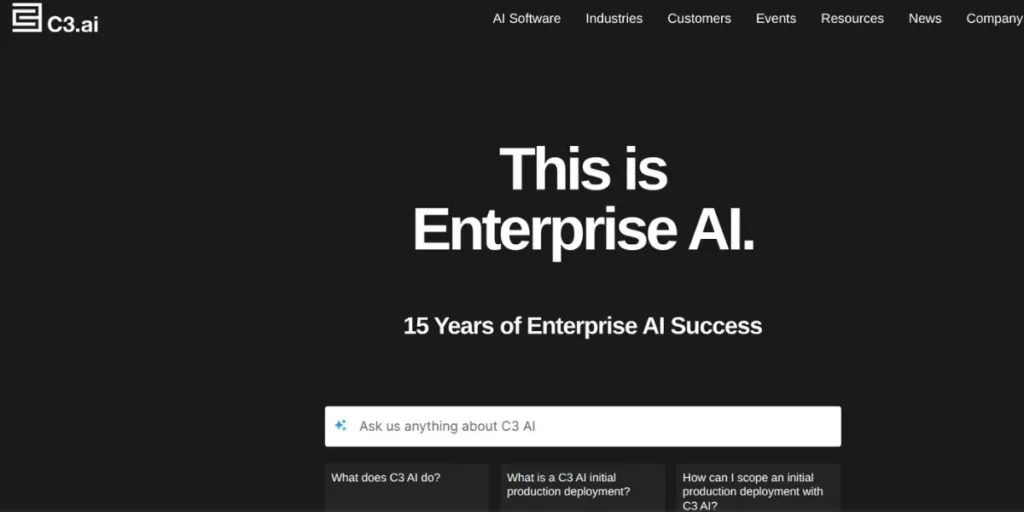
C3 AI is not similar to the other platforms. It is intended to be used on giant-scale industrial Abacus AI Alternatives projects. Imagine that it is the platform where AI operates on behalf of a power grid, the entire fleet of an airline, or a massive factory. C3 AI assists companies to construct and operate these large, intricate AI systems quicker than it would individually. It provides pre-built solutions to the energy, manufacturing, and financial industries.
It saves time since businesses are not forced to develop them. C3 AI is not a product of individuals and small teams. It is an effective instrument in the hands of large companies with problems of mission. It aims at assisting large corporations in applying AI in order to become more effective and address significant issues.
Key Features:
- Model-Driven Architecture: This is a special method of creating AI applications, which simplifies their creation and maintenance.
- Pre-trained AI Solutions: A ready solution to problems that are common to industries.
- Industry Scalability: Designed to support large industry companies with their massive data and complexity.
- End-to-End Platform: Includes all the data integration to the operation of the final AI application.
Pros:
- Rapidly accelerates the creation of massive AI applications.
- Strong industry specific knowledge base and industry solutions.
- Scalable and can be used in critical business.
- Powerful platform of integrating all data of a company.
Cons:
- Quite costly and only suitable to large business.
- It is dedication intensive and may be complicated to master.
- Not applicable to general-purpose and small-scale AI.
Pricing:
Custom contracts provide pricing, which is typically highly expensive, since it is aimed at large businesses.
Website:
7. Databricks
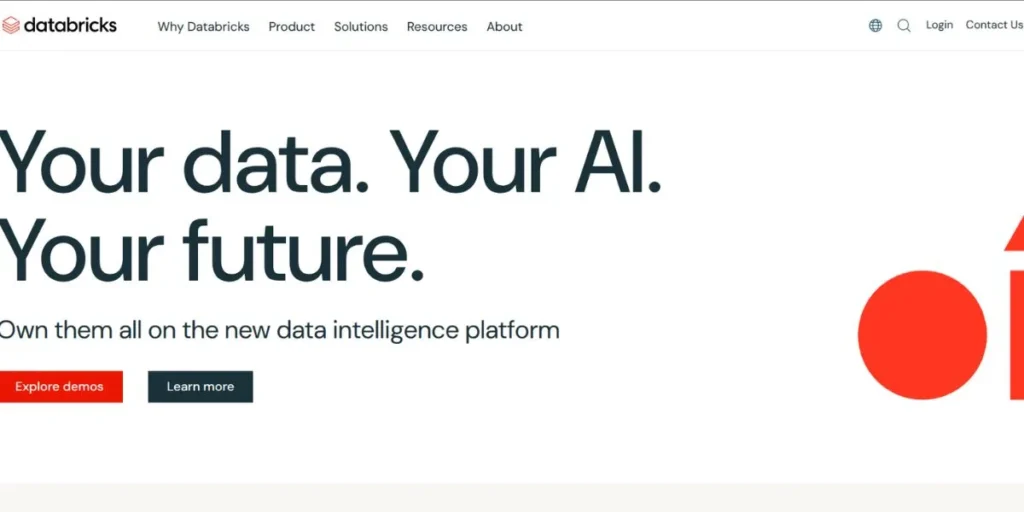
The same authors of Apache Spark, a very fast big data tool, have created Databricks. Think of Databricks then as a data-intensive tool, in particular, large data and Abacus AI Alternatives. It refers to its system as a Lakehouse, a combination of the finest elements of a data warehouse (structured data) and a data lake (unstructured data).
On top of this foundation, Databricks offers potent Abacus AI Alternatives and machine learning. It is designed to have teams of data engineers, data scientists and business analysts collaborating under a single location. When you need to work with really large, messy data and run AI on it,
Key Features:
- Lakehouse Platform One place to store your data, analysis and AI.
- Apache Spark based -Very strong at big data.
- Collaborative notebooksTeams are able to share code and data.
- Delta Lake A reliable storage layer, which is open-source.
Pros:
- Excellent with massive data sets.
- Collaborates well with other data teams.
- One system simplifies the entire process.
- It is compatible with numerous tools and cloud solutions.
Cons:
- Hard to set up and manage.
- Ideal to those who enjoy coding.
- It may be expensive when you consume a significant amount of data.
Pricing:
You pay as you use. There is a 14‑day free trial.
Website:
https://www.databricks.com
8. Alteryx
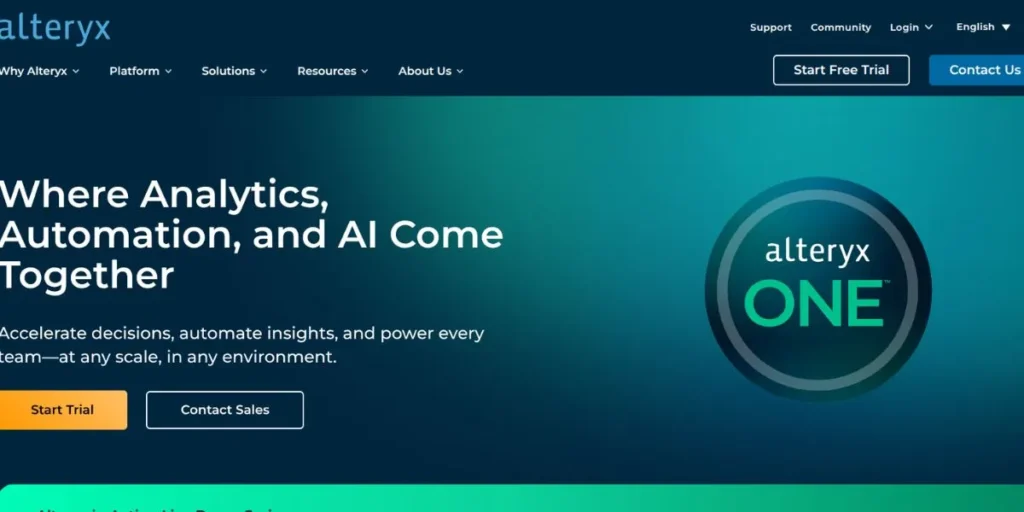
Alteryx is a great abacus AI alternatives. It also allows the use of data by any person in an organization, not only specialists. It is characterized by visual, simple manner of manipulating data. Imagery: It should be viewed as a collection of digital building blocks. You drag something onto a canvas, connect shapes and create a workflow. The workflow has the ability to clean data, combine it with other data, analyze it, and even create simple AI models.
It is compiled to address the needs of business analysts and other people, who are familiar with business issues but do not code. Alteryx transforms difficult data operations into easy enjoyable processes. It is not the best Abacus AI Alternatives powered, but it is very useful when it comes to data preparation and analysis. It links business users and data science.
Key Features:
- The interface is called Visual Workflow Designer, and it allows one to build data processes with the help of drag-and-drop.
- Data Prep and Blending – Data cleaning and data combining tools used with large numbers of sources.
- Automated Analytics -Create predictive models without coding.
- Location Analytics Map and geographic data functionality.
Pros:
- Very user friendly, particularly to non-coders.
- Simplifies the complicated data preparation.
- Enables business users to perform self analysis.
- Well-knit user community.
Cons:
- It might be costly since it is marketed as an annual membership.
- Machine learning capability is not as sophisticated as dedicated AI systems.
- Does not necessarily work well with very large volumes of data as databases such as Databricks.
Pricing:
Alteryx is marketed on a subscription basis license. Their sales team can be contacted to give prices. They offer a free trial.
Website:
https://www.alteryx.com
9. KNIME
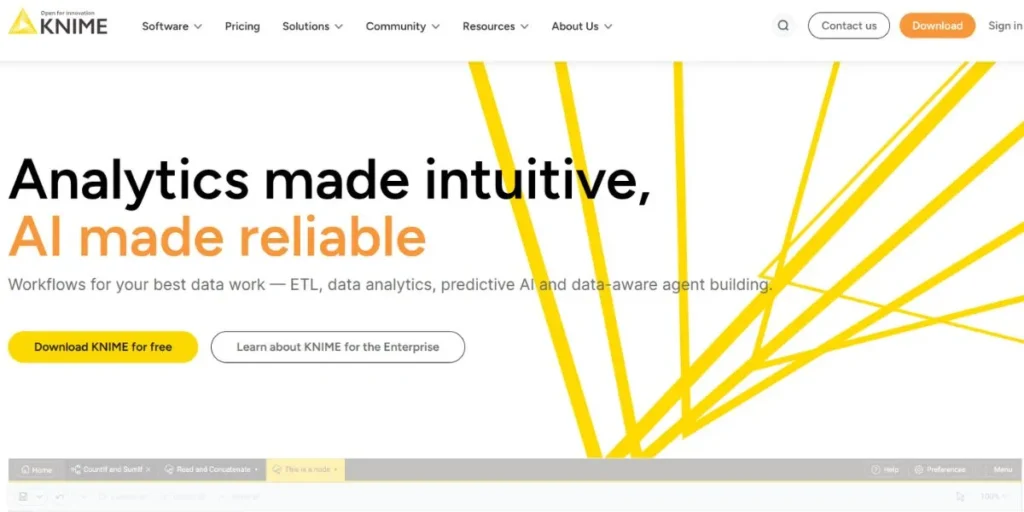
KNIME (pronounced naim) is a great abacus AI alternatives. It is an open-source and free platform. This contributes to its popularity among students, academics, and professionals who require a powerful tool but do not want to spend so much money on it. KNIME, like Alteryx, has a visual, drag-and-drop workflow. You link various nodes together, each node does something like reading a file, filtering data or training a model.
Thousands of nodes are available and you can create highly complex workflows. KNIME is a full platform capable of doing all things, including connecting to data sources, to interactive visualizations. It is open source on your desktop, and they do have a commercial KNIME Server that businesses require more collaboration and workflow management.
Key Features:
- Open-source and Free-of-charge The primary analytics platform is totally free.
- Visual Workflow Node-based framework used to create data analysis and machine learning workflows.
- Thousands of nodes to do many things.
- Well-Established Community A big community is one that shares workflows with others and assists new users.
Pros:
- Free, a big advantage.
- extremely strong and versatile; you can create anything.
- Not too difficult to learn the basics since it is visual.
- No connection to a particular cloud provider.
Cons:
- May be slower than commercial software, particularly when using very large workflows.
- The interface appears somewhat outdated as compared to newer tools.
Pricing:
KNIME Analytics Platform is a free platform. The KNIME Business Hub teams is a commercial product available on a custom price.
Website:
https://www.knime.com
10. RapidMiner
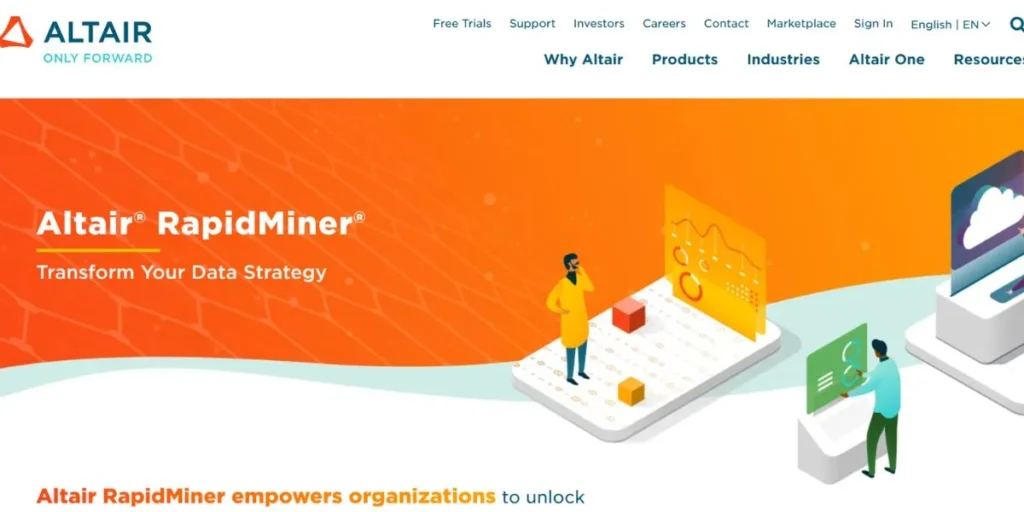
RapidMiner is a great abacus AI alternatives. It is a platform that is long-used and assists individuals in performing data science. It desires to be a one-stop shop to do all the steps, including cleaning data, creating and putting models to work. Similar to Alteryx and KNIME, it does allow a visual workflow builder to enable no-code work. It also possesses automated AI tools and code options hence it suits teams with various skills. RapidMiner prioritizes the actual business outcomes of data and desires everyone in an organization to make use of data science.
Key Features:
- Auto Tools and Visual and Auto Design: Provides both a drag-and-drop interface (RapidMiner Studio) and auto tools (Auto Model).
- Complete Platform: Manages prep, model operations and machine learning.
- Text Mining: powerful text analysis tools.
- Extensible: Add functionality on its marketplace.
Pros:
- Easy to use but powerful.
- Is useful with teams with mixed skills.
- Has a free version that is generous.
- plenty of study materials and manuals.
Cons:
- UI may be complicated to new users.
- Free version has restrictions on the amount of data you can use.
Pricing:
RapidMiner has a free plan that has restrictions. Paid plans include additional functionality and capacity; it is charged per request.
Website:
https://www.rapidminer.com
Conclusion
Abacus AI alternatives are an excellent AI building tool, but not the only one. Such platforms as DataRobot can make models within minutes. Large cloud providers such as Google, Amazon, and Microsoft provide you with numerous opportunities. Such tools as Alteryx and KNIME allow anyone to apply data science using visual interfaces.
The optimal AI platform is not the one that features the most or has the biggest name. It is the one that assists you in solving your problems and transforming your ideas into reality in the simplest manner. Reflecting on your purposes, abilities and financial resources allows you to locate the appropriate AI partner.
FAQs
Should I be aware of how to code to use these tools?
No! Numerous tools such as Alteryx, KNIME and DataRobot are non-coded. They feature visual drag and drop interfaces, allowing you to create powerful objects without the use of code.
What does “AutoML” mean?
AutoML is Automated Machine Learning. The platform will automatically run numerous models and settings to identify the most suitable one to your data. It is as though you have a helper robot.
How does an open-source tool differ from a paid tool?
A free open-source software such as KNIME or the free edition of H2O.ai is free to manipulate. A paid tool is one that is sold by a company and typically includes additional features, support and is sometimes simpler to use immediately.
Are these sites suitable for a small school project?
Yes! KNIME is a free tool that is ideal in school projects. Google Cloud AI, Amazon SageMaker, and Microsoft Azure ML also offer free tiers that you can use to learn and experiment without any money.
